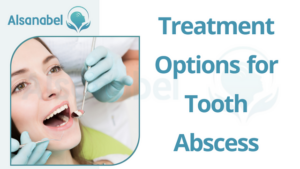Tooth abscess is a serious dental condition that should not be ignored. It is a painful infection that occurs when bacteria invade the tooth, causing inflammation and the formation of pus. If left untreated, it can lead to serious health complications and the loss of the affected tooth. Early detection and treatment are crucial in preventing further complications and preserving oral health.
Types of tooth abscess
There are two main types of tooth abscess: periapical abscess and periodontal abscess.
- Periapical Abscess: This type of abscess occurs at the tip of the tooth’s root. It is primarily caused by an untreated dental cavity or untreated dental trauma. The infection spreads from the dental pulp to the surrounding tissues, leading to the formation of an abscess.
- Periodontal Abscess: This type of abscess occurs in the gums or the bone that supports the teeth. It is usually caused by gum disease (periodontitis) and occurs when bacteria invade the deep spaces between the gums and teeth, leading to infection and abscess formation.
Causes of Tooth Abscess

Poor oral hygiene and dental decay
Neglecting proper oral hygiene practices can increase the risk of tooth abscess. When teeth are not regularly brushed and flossed, plaque and bacteria can build up, leading to tooth decay. Dental decay weakens the tooth enamel, creating an entry point for bacteria to invade the tooth and cause infection.
Maintaining good oral hygiene habits, including brushing twice a day, flossing daily, and visiting the dentist regularly, can help prevent tooth decay and reduce the risk of tooth abscess.
Untreated dental infections and gum disease
Dental infections, such as untreated dental cavities or cracked teeth, can progress and result in a tooth abscess if left untreated. These infections provide an opportunity for bacteria to penetrate the tooth, leading to inflammation and pus formation. Additionally, gum disease, known as periodontitis, can also contribute to the development of a tooth abscess.
As gum disease progresses, pockets can form between the gums and teeth, allowing bacteria to enter and cause infection. Regular dental check-ups and prompt treatment of dental infections and gum disease are essential in preventing tooth abscess.
Symptoms of Tooth Abscess
Pain and sensitivity in the affected tooth
One of the most common symptoms of a tooth abscess is pain and sensitivity in the affected tooth. This pain is often described as a throbbing or sharp sensation, and it may worsen when biting or chewing. The tooth may also be sensitive to hot and cold temperatures. These symptoms occur because the infection irritates the nerves within the tooth.
Swelling and redness around the tooth or gums
Another symptom of a tooth abscess is swelling and redness around the affected tooth or gums. The area may appear swollen, and the gums may be tender to touch. The swelling can extend to the face and neck, especially if the infection has spread beyond the tooth and into the surrounding tissues.
Other symptoms that may accompany a tooth abscess include:
- Bad breath or a foul taste in the mouth
- Fever
- Difficulty opening the mouth or swallowing
- Lymph nodes under the jaw or neck becoming swollen and tender
Remember, early detection and treatment are key to preventing further complications and resolving the infection. If you suspect you have a tooth abscess, contact your dentist as soon as possible for an evaluation and appropriate treatment.
Diagnosis of Tooth Abscess
Physical examination and dental history assessment
To diagnose a tooth abscess, a dentist will first perform a physical examination and assess the patient’s dental history. The dentist will examine the affected tooth, looking for signs of swelling, redness, or discharge. They will also ask the patient about their symptoms and any previous dental issues or treatments.
Dental X-rays and imaging tests
Dental X-rays and other imaging tests are often used to confirm the diagnosis of a tooth abscess. X-rays can reveal changes in the bone surrounding the tooth, which may indicate an infection. In some cases, the dentist may also order a computed tomography (CT) scan or an ultrasound to get a more detailed picture of the abscess and to determine its extent.
During the imaging process, the dentist will look for specific signs of a tooth abscess, such as a visible pocket of pus or a darkened area around the tooth root. These images will help the dentist determine the severity of the abscess and plan the most appropriate treatment.
In some situations, the dentist may also perform a pulp vitality test to assess the health of the tooth’s pulp. This test involves applying hot or cold temperatures to see if the tooth responds normally. If there is little to no response, it may indicate that the abscess has caused irreparable damage to the pulp.
Once a tooth abscess has been diagnosed, the dentist will discuss the treatment options with the patient and recommend the most appropriate course of action. Prompt diagnosis and treatment are crucial to prevent the spread of infection and to preserve the affected tooth. Therefore, it is important to seek professional dental care if you suspect you have a tooth abscess.
Treatment Options for Tooth Abscess

Root canal therapy and tooth extraction
After diagnosing a tooth abscess, the dentist will discuss the available treatment options with the patient. Two common treatment approaches for tooth abscesses are root canal therapy and tooth extraction.
- Root canal therapy: This procedure involves removing the infected pulp from the tooth and cleaning out the abscess. The dentist will then fill the space with a special material and seal it to prevent further infection. Root canal therapy is often recommended when the tooth can be saved, as it allows for the preservation of the natural tooth structure.
- Tooth extraction: In some cases, the tooth abscess may be too severe for root canal therapy or the tooth itself may be too damaged to save. In these situations, the dentist may recommend a tooth extraction. During this procedure, the dentist will carefully remove the infected tooth from its socket. After extraction, the dentist may place a dental implant or recommend other tooth replacement options.
Antibiotics and pain management
In addition to dental procedures, antibiotics and pain management strategies are often used to treat tooth abscesses.
- Antibiotics: Antibiotics are prescribed to help control the infection and prevent its spread. Commonly prescribed antibiotics for tooth abscesses include penicillin, amoxicillin, and clindamycin. It is important to take the full course of antibiotics as prescribed by the dentist to ensure the infection is completely eradicated.
- Pain management: Tooth abscesses can be very painful, and pain management techniques may be necessary to provide relief. Over-the-counter pain medications such as ibuprofen or acetaminophen can help alleviate pain and reduce inflammation. The dentist may also prescribe stronger pain medications if necessary.
It is important to note that while antibiotics and pain management can provide temporary relief, they do not eliminate the underlying cause of the tooth abscess. Dental treatment, such as root canal therapy or tooth extraction, is necessary to remove the infection and prevent further complications.
Complications of Untreated Tooth Abscess
Spread of infection to surrounding teeth and tissues
If a tooth abscess is left untreated, the infection can spread to the surrounding teeth and tissues. The bacteria from the abscess can enter the bloodstream and travel to other parts of the body, leading to systemic infection. This can cause further complications, including:
- Dental caries: The infection can spread to nearby teeth, causing decay and damage to their enamel and inner structures.
- Gum disease: The bacteria can invade the gums and cause inflammation, leading to gum disease. This can result in gum recession, tooth loss, and bone deterioration.
- Sinusitis: If the upper teeth are affected, the infection can spread to the sinuses, causing sinusitis. Symptoms may include facial pressure, pain, congestion, and nasal discharge.
- Osteomyelitis: In rare cases, the infection can spread to the jawbone, causing osteomyelitis. This condition can lead to severe pain, bone destruction, and even life-threatening complications if left untreated.
Facial swelling and cellulitis
Untreated tooth abscesses can also cause facial swelling and cellulitis. As the infection spreads, the surrounding tissues can become inflamed and swollen, resulting in visible facial swelling. Cellulitis, a bacterial skin infection, can occur when the infection penetrates the deeper layers of skin. Symptoms of cellulitis may include redness, warmth, pain, and swelling in the affected area.
If left untreated, facial swelling and cellulitis can worsen and lead to abscess formation, difficulty breathing or swallowing, and even airway obstruction. In severe cases, the infection can spread to the brain, causing potentially life-threatening complications such as meningitis or a brain abscess.
Prevention of Tooth Abscess
Importance of regular dental check-ups and oral hygiene
Regular dental check-ups play a crucial role in preventing tooth abscesses. Dentists can identify any signs of decay or infection early on and take appropriate measures to prevent them from progressing into abscesses. They can also clean your teeth professionally, removing plaque and preventing the buildup of bacteria that can lead to infections.
Additionally, dentists can provide guidance on proper oral hygiene practices, including brushing and flossing techniques, and recommend products that can help maintain your oral health. By visiting your dentist regularly and following their advice, you can reduce the risk of developing a tooth abscess.
Proper oral care and diet choices
Maintaining proper oral care is essential in preventing tooth abscesses. This includes brushing your teeth at least twice a day with fluoride toothpaste, flossing daily to remove plaque and food particles from between your teeth, and using mouthwash to kill bacteria that may cause infections. It is also important to avoid tobacco and limit your consumption of sugary and acidic foods and beverages, as they can contribute to tooth decay and gum disease. Instead, opt for a healthy diet rich in fruits, vegetables, and calcium-rich foods that promote strong teeth and gums.
Taking steps to prevent tooth abscesses is far easier and less painful than having to undergo treatment for them. By practicing good oral hygiene, getting regular dental check-ups, and making healthy lifestyle choices, you can significantly reduce the risk of developing a tooth abscess and maintain a healthy smile for years to come. Remember, prevention is always better than cure when it comes to your oral health.
Home Remedies for Tooth Abscess

Saltwater rinses and over-the-counter pain relievers
There are some home remedies that can help provide temporary relief from the pain and discomfort caused by a tooth abscess. One of the most common remedies is rinsing the mouth with warm saltwater. Saltwater can help reduce swelling and kill bacteria, providing some relief from the abscess. Mix half a teaspoon of salt in eight ounces of warm water and rinse your mouth thoroughly a few times a day.
Over-the-counter pain relievers, such as ibuprofen or acetaminophen, can also help alleviate the pain associated with a tooth abscess. However, it’s important to note that these remedies only provide temporary relief and should not be considered a substitute for professional dental care.
When to seek professional dental care
While home remedies can offer temporary relief, it is crucial to seek professional dental care as soon as possible for the treatment of a tooth abscess. Tooth abscesses are a serious dental condition that require proper diagnosis and treatment from a dentist.
Here are some signs that indicate you should seek professional dental care for a tooth abscess:
- Severe, persistent toothache
- Sensitivity to hot or cold temperatures
- Swelling in the face or cheek
- Fever or other signs of infection
- Difficulty swallowing or breathing
If you experience any of these symptoms, it is important to schedule an appointment with your dentist immediately. Ignoring or delaying treatment can lead to the infection spreading to other areas of the body or causing further damage to the tooth and surrounding tissues.
Remember, home remedies can only provide temporary relief and are not a substitute for professional dental care. Seeking prompt treatment from a dentist is crucial to effectively treat a tooth abscess and prevent any complications.
Importance of prompt dental care to prevent complications
Seeking prompt dental care is crucial when dealing with a tooth abscess. Ignoring or delaying treatment can lead to the infection spreading to other parts of the body, causing more serious health issues. It can also result in damage to the tooth and surrounding tissues, potentially leading to tooth loss.
Professional dental care is essential for proper diagnosis and treatment. Dentists have the expertise to identify and treat tooth abscesses effectively, providing long-lasting relief from pain and preventing complications. Home remedies such as saltwater rinses and over-the-counter pain relievers can provide temporary relief but should not be relied upon as a substitute for dental care.
In conclusion, if you are experiencing symptoms of a tooth abscess, such as severe toothache, swelling, or signs of infection, it is important to schedule an appointment with your dentist as soon as possible. Prompt intervention can prevent complications and ensure proper treatment. Remember, taking care of your oral health is essential for overall well-being.
